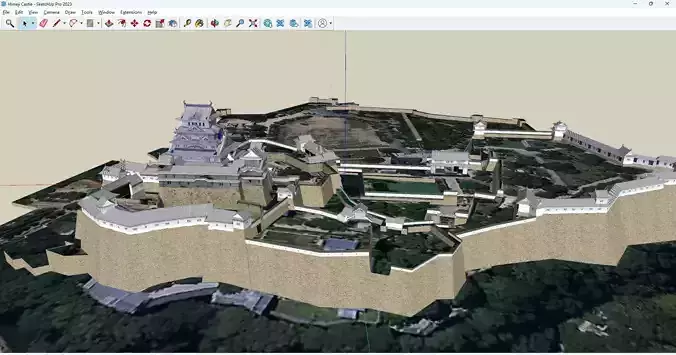1/5
It's is a very simplified himeji castle model
Himeji Castle (姫路城, Himeji-jō) ([çimeʑiꜜʑoː] ⓘ) is a hilltop Japanese castle complex situated in Himeji, a city in the Hyōgo Prefecture of Japan. The castle is regarded as the finest surviving example of prototypical Japanese castle architecture, comprising a network of 83 rooms with advanced defensive systems from the feudal period.[7] The castle is frequently known as Hakuro-jō or Shirasagi-jō (White Egret Castle or White Heron Castle) because of its brilliant white exterior and supposed resemblance to a bird taking flight.[6][8]
As with almost all Japanese castles from the Azuchi-Momoyama period onward, the tenshu (天守, main keep), the most prominent structure, was used as a storehouse in times of peace and as a fortified tower in times of war, and the daimyo (大名, feudal lord)'s government offices and residences were located in a group of single-story buildings near the tenshu and the surrounding yagura (櫓, turrets).[9]
Himeji Castle dates to 1333 when Akamatsu Norimura built a fort on top of Himeyama hill. The fort was dismantled and rebuilt as Himeyama Castle in 1346 and then remodeled into Himeji Castle two centuries later. Himeji Castle was then significantly remodeled in 1581 by Toyotomi Hideyoshi, who added a three-story castle keep. In 1600, Tokugawa Ieyasu awarded the castle to Ikeda Terumasa for his help in the Battle of Sekigahara, and Ikeda completely rebuilt the castle from 1601 to 1609, expanding it into a large castle complex.[3] Several buildings were later added to the castle complex by Honda Tadamasa from 1617 to 1618.[5] For almost 700 years, Himeji Castle has remained intact, withstanding incidents such as the bombing of Himeji in World War II, and natural disasters, including the 1995 Great Hanshin earthquake.[3][2][10]
Himeji Castle is the largest and most visited castle in Japan, and it was registered in 1993 as one of the first UNESCO World Heritage Sites in the country.[2] The area within the middle moat of the castle complex is a designated Special Historic Site and five structures of the castle are also designated National Treasures.[5][11] Along with Matsumoto Castle and Kumamoto Castle, Himeji Castle is considered one of Japan's three premier castles.[12] The castle buildings underwent restoration work for several years and reopened to the public on March 27, 2015.[13] The works also removed decades of dirt and grime, restoring the formerly grey roof to its original brilliant white color.
REVIEWS & COMMENTS
accuracy, and usability.





